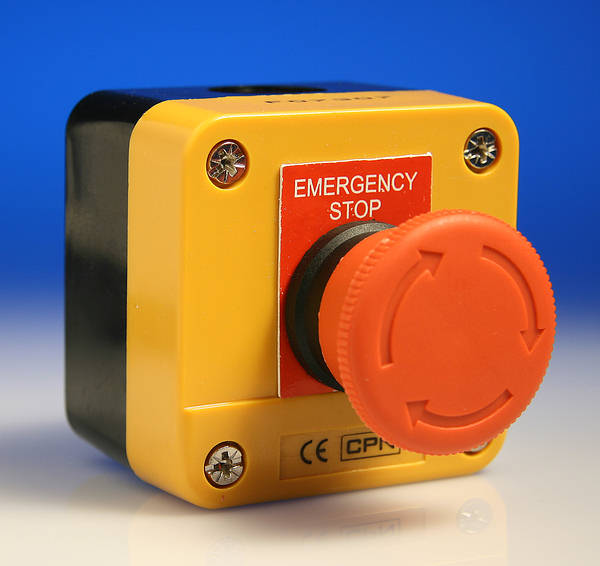E-stop and M-stops
by David Kohanbash on January 1, 2014

Hi all
Just a quick note on e-stops (emergency stops) and m-stops (mobility stops).
There are various levels of e-stops. In an ideal world an e-stop would kill power to ALL power, however in complex systems we often settle for less. Some reasons for a weaker e-stop is to keep the computers and other sensors from turning off. In many cases when we say e-stop we really mean a m-stop. An m-stop lets all motion be stopped which is most often the cause of an e-stop needing to be pressed. It is important that when an e-stop/m-stop is released the robot will not resume its unsafe operation.
When using an e-stop/or m-stop it is important to think about how the robot will respond in different situations. For example if a robot is on a hill will it start to back drive the motors? If so is the proper thing to kill the mobility bus power or is it to have the motor servo in place, or maybe even to add brakes to the motor.
It is also important to think about access to the e-stop/m-stop. If a vehicle is large or traveling fast it might not be practical or safe to press the physical button on the robot. In these cases a wireless e-stop/m-stop is needed. A wireless e-stop/m-stop should be very reliable and operate on a separate radio channel as everything else. It is highly desirable for there to be heartbeats between the e-stop/m-stop and the robot. This will insure that the robot will safely stop when commanded or communication is lost.
Another use for these e-stop/m-stop buttons are to guarantee the robot will not move unexpectedly when you are working on them. Pressing the buttons when ever you are working on the robot or not using the robot is a good safety habit to adopt.
When choosing an e-stop/m-stop make sure it is strong and can take a hit as you slam it with your fist. Also a latching variety is good where you need to twist it in order to release the button. In an ideal world and for a proper e-stop the switch should kill power directly. A good source of high current switches are in marine catalogs for boats. However we must sometimes use relays or contactor so we can use a small current in the switches to kill the large current power bus. For m-stops you often can kill power to just the motor amplifiers or trigger an inhibit line on the motor controller.
A classic example of why e-stops are important and must be wired correctly is that During the second DARPA Grand Challenge in 2005 the Golem 2 self driving car had a computer failure that sent it on a 60mph rampage that was not able to be stopped due to the wireless e-stop not being integrated properly.
An example e-stop switch rated to 250A is here www.cloudelectric.com and is pictured below.

e-stop image from http://www.tlc-direct.co.uk/


Comments
[…] is that robots can move on their own and and act on their own. At the most basic level having an emergency stop that can be used to make sure the robot does not start moving and so it can be stopped in the event […]
Hey David,
In your experience what has been the most reliable and or economic wireless E-Stop / M-stop solution? This question always comes up when we are testing robots and we find that it is not always a trivial matter for the desired reliability and economics.
Great question! There are two approaches to this; you can spin your own solution or purchase one.
There are several commercially available ones on the market. You need to pay attention to what happens if the wireless estop losses radio contact with the receiver on the robot, and what the response is. Some of the “cheaper” systems do not have any type of heartbeat/keep-alive signal. This one from TORCROBOTICS http://www.torcrobotics.com/products/safestop-wireless-emergency-stop-system-unmanned-ground-vehicles allows you to pause the robot, and has a good form factor. http://www.bwieagle.com/ also has some that are MSHA (mining regulaory agency) approved, however it is not clear if all of them use heartbeats. The http://www.bwieagle.com/products-home/remote-controls/dozer-stop-switch-systems/ system appears to use heartbeats. http://www.aee.us.com/Products_Estop.html also has some interesting products that allow a single controller to kill several robots and visa-versa.
If you make your own an easy way to do it is by putting a small radio (such as from Digi) on the robot and on your estop. You can then send heartbeat messages from the estop to the robot. If the estop is activated or the heartbeats stop the robot should come to a stop. There are various degrees of reliability here based on how you design it. For example if the radio goes to the main computer and the computer fails the e-stop might not work, so having independent hardware for the e-stop system is a good idea. You could imaging that the estop radio talks to a small microprocessor that controls a relay allowing it to kill power.
Cheers!
[…] in a way that people can not touch it and labeled as such. Some key electrical components are emergency stops (e-stops) that cut off all power to the robot, motion stops (m-stops) that provide a…, shunt regulators to protect robot systems from motors being back driven (make sure the shunt […]
[…] part of the requirements we needed to integrate a wired and wireless estop (read here to see why this was not actually an estop) to stop the robots in case of any unsafe behavior. I also like to have a physical estop button to […]